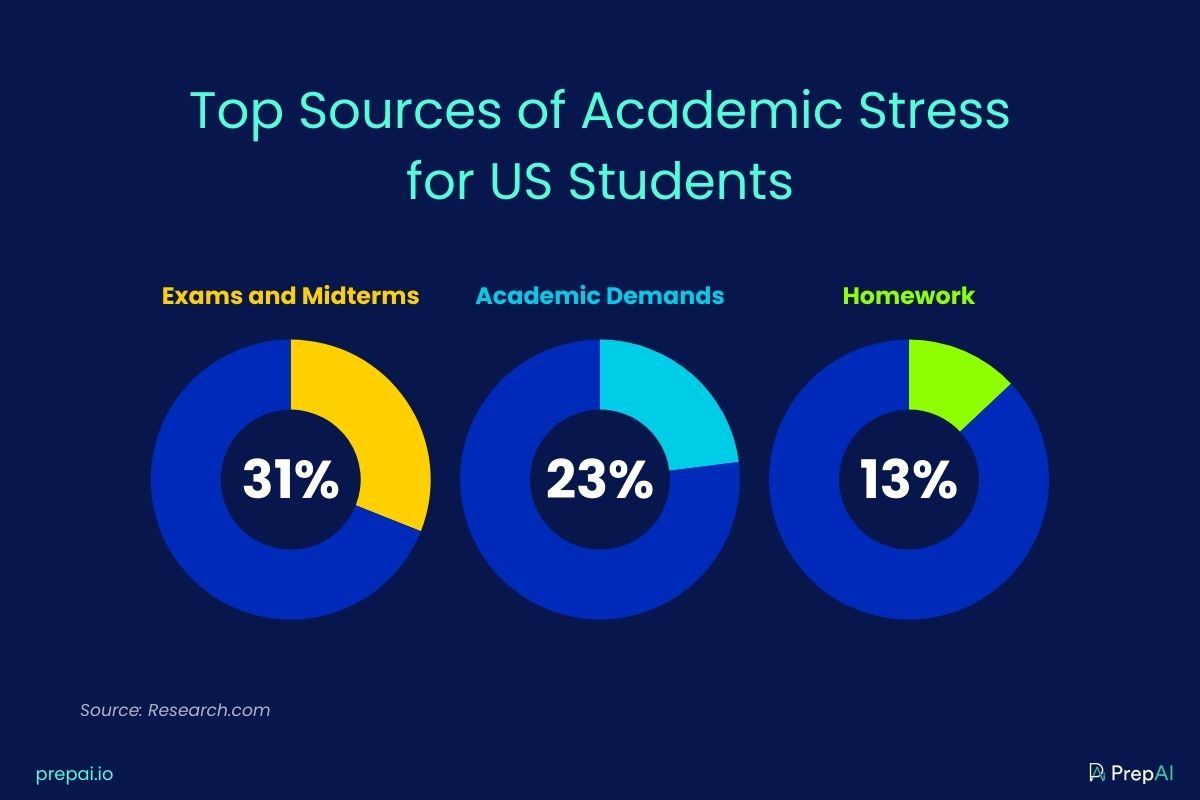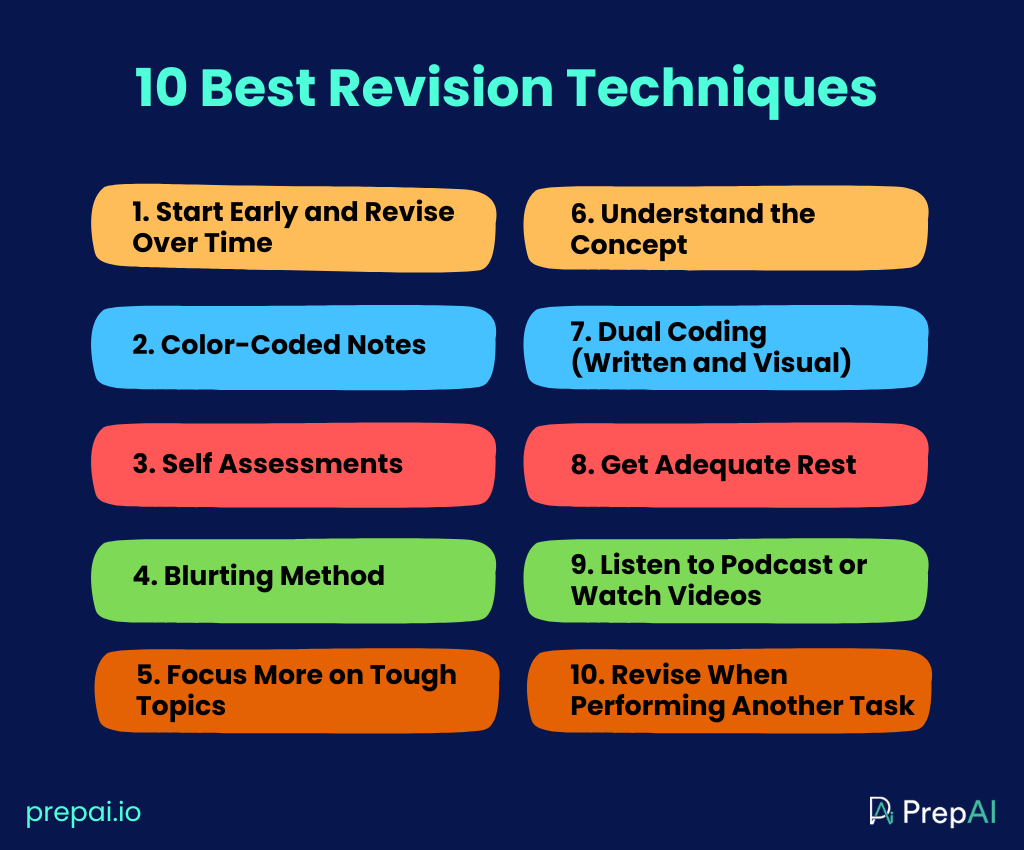Revising for exams doesn’t have to drain your energy and fill you with dread. There’s no need to say goodbye to playing and spend all your time studying. Here, we’ll discuss what the best revision techniques are for students to improve their ranks in the exams and achieve their goals.
The education sector is one of the biggest industries in the world. Millions of students from schools, colleges, and universities, homeschoolers, working professionals, etc., attend examinations relevant to their fields. Preparing for exams can be stressful due to the vast syllabus you need to cover. Moreover, many students worry about how they would retain every piece of information learned.

We are here to help you. In this blog, you will find a list of the best revision techniques for exams. Choose the methods that suit your learning style and put them into practice.
Best Revision Techniques
Generally, we tend to revise by making notes, highlighting important points with a marker, and reading the same material a few times. You have to read and read, which makes you tired and stressed. However, by incorporating different types of revision techniques into your schedule, you can effectively revise more material in less time and remember what you learned. You also don’t have to ignore other aspects of your life.

So, what are the best revision methods? Read below!
1. Start Early and Revise Over Time
The best revision method is to start well in time so that you can space out studying and revising. Don’t wait until the last minute and rush through the syllabus. The sooner you start, the more time you will have to revise everything and test your knowledge.
2. Color-Coded Notes
Different revision techniques appeal to different readers. If you enjoy making lists or structuring your lessons into a specific format, color-coded notes are a good method to try. Assign a color to each subject/ topic. Then use the post-it notes to mark important parts and create a connection between these parts. That way, you can revise the notes for each color together.
3. Self Assessments
Do you know what the most effective revision method is? Self-assessment. Yes! How else will you determine whether you have retained the information? Use online AI exam generator tools like PrepAI to create test papers. The platform will also grade your answers and give immediate results. Identify weak areas, study again, and attempt another test until you score the marks you want. It is built on Bloom’s taxonomy framework and creates critical thinking questions.
4. Blurting Method
The blurting method is also called memory dump or brain dump. So, what is the brain dump technique for revision? It is where you read a portion of the topic, close the book, and write down as much as you remember. You ‘blurt out’ the information you retained after reading. Compare notes and revise again until you can recollect most of them. This method has gone viral on TikTok.
5. Focus More on Tough Topics
Don’t leave hard topics until the end. Start with complex subjects and topics so that you have enough time to learn the concept. You can also discuss your doubts with your friends or teachers and look up more information online (or in the libraries). Once you finish hard topics, start with the simpler ones.
6. Understand the Concept
One of the best revision techniques is to understand the concept instead of simply memorizing the text through rote. This allows you to have a clear idea of the topic so that you can answer the relevant questions using your own words. It also stays in your memory longer.
7. Dual Coding (Written and Visual)
Dual coding is a great revision technique as it combines two forms of learning. Here, you read the text and look up the relevant images to get a visual representation of the same. Or, you could draw the same yourself to see if you have understood the topic.
8. Get Adequate Rest
Rest and sleep are important for your body and brain to cooperate. Some students ask if it is better to revise at night or day. Typically, revise at night when there are fewer distractions and go to sleep. This will allow the brain to process and store the information. Then revise again the next morning to ensure you didn’t forget anything important. However, don’t stay awake late into the night and wake up early. Get enough rest.
9. Listen to Podcast or Watch Videos
Some people need audiovisual simulations to understand the topic and revise it thoroughly. Reading a block of text doesn’t work for them. If you belong to this group, search for podcasts and videos by experts (or your teachers if you have eLearning options). Listen or watch the lessons and make notes simultaneously. Then, revise the notes later (your brain will replay the words as you read).
10. Revise When Performing Another Task
This technique can be termed as the opposite of the blurting method of studying. Here, you don’t immediately try to recollect the information. Instead, you do it later when you are performing another task. For example, you have studied a topic in the morning. Later in the day or after a couple of days, you should try to recollect the information when you are taking a bath, cleaning the desk, gardening, etc., to assess how much you understand and remember.
Conclusion
These revision tips are helpful for students of various age groups and learning styles. However, note that the same method may not work for everyone. You should identify the ones that suit your strengths and implement them. You can tweak the techniques to get better results. However, self-assessments are non-negotiable. Everyone should measure their learning by attempting practice tests as often as possible. This will also prepare you to complete the final exam within the duration without feeling stressed or anxious. Check out PrepAI, an AI-based question paper generator tool, designed to help students, teachers, parents, and trainers conduct assessments in real-time.
Frequently Asked Questions (FAQs)
1. What is the 2 3 5 7 rule for revision?
The 2357 rule is one of the best revision techniques for memorizing important topics for exams. In this method, you read the notes on day one and then again on day two and day three. Then, you take a break on day four and revise on day five. Next, you take a break on day six and revise on day seven. This increases retention power.
2. What is the 1 2 4 7 revision technique?
The 1247 revision technique is where you study once and revise thrice with adequate breaks in between. Study on day one and revise on day two. Then, take a break on day three and revise on day 4. Now, take a break on days five and six and revise on day seven.
3. What are the three R’s of revision?
The three R’s of revision are review, reread, and react (reshape). First, you review the study material and make notes. Next, you reread the notes to recollect information. Then, you reshape by writing it down in your own words. This helps understand the concept and memorize it.
4. What is the 80/20 rule in revision?
The 80-20 rule of revision is called the Pareto Principle, which states that 80% of the outcome will depend on 20% of your input efforts. In this method, you put more effort into important topics to maximize your score.
5. What are the four levels of revision?
The four levels of revision are – review (keep data ready and make a plan), revise (start making notes), reassess (test yourself to assess your knowledge), and reflect (evaluate the results to make improvements).
6. What is scientifically the best way to revise?
Spaced repetition is one of the best scientific revision techniques. It lets you revise multiple times while taking enough breaks in between days so that the brain has time to process everything. This increases retention and recollection abilities.
7. What are the ineffective revision techniques?
Re-reading the same notes repeatedly without taking breaks or switching to another topic is the most ineffective revision technique. While it was popular previously, studies show it is not effective in helping students understand the concepts or retain the information for long.




